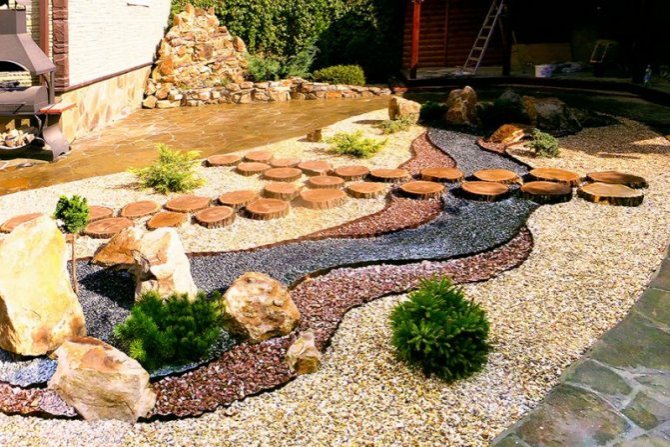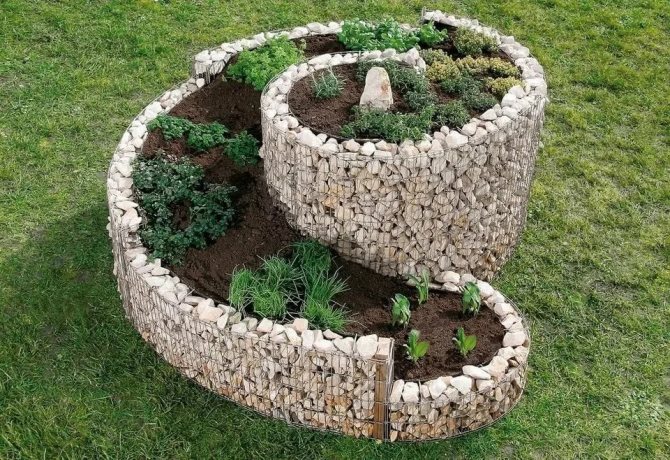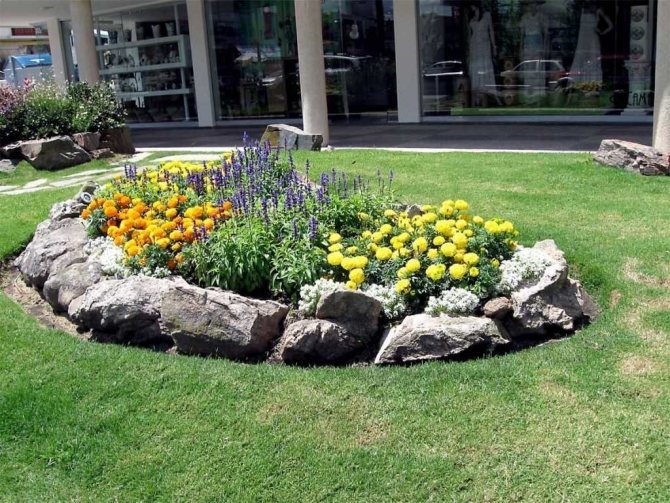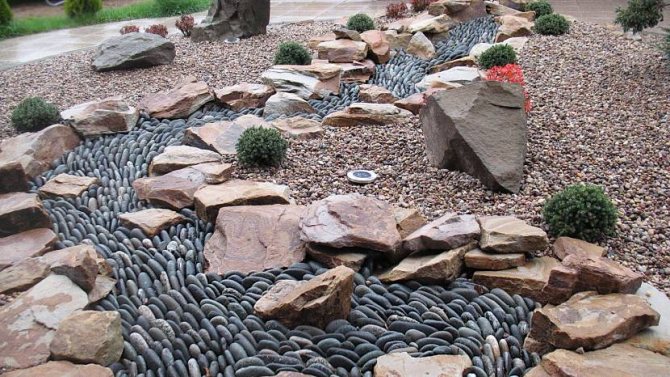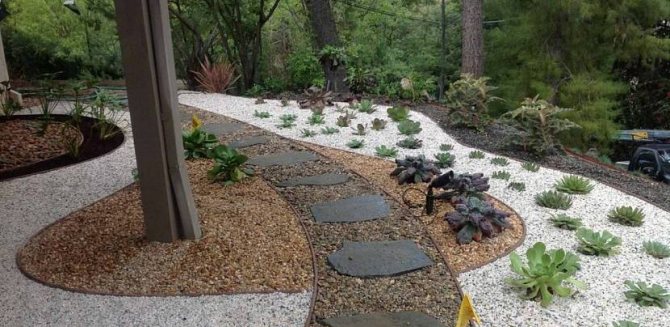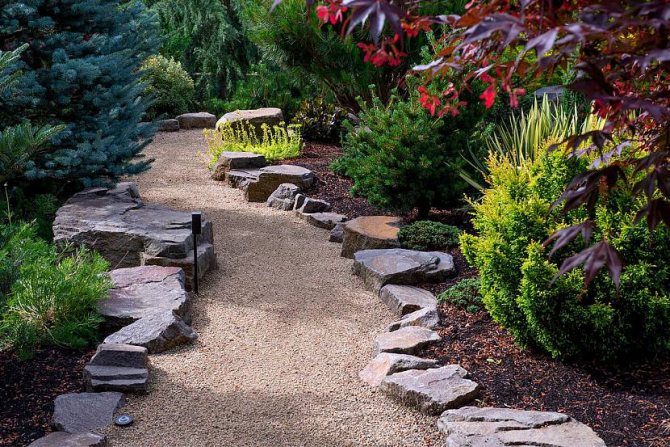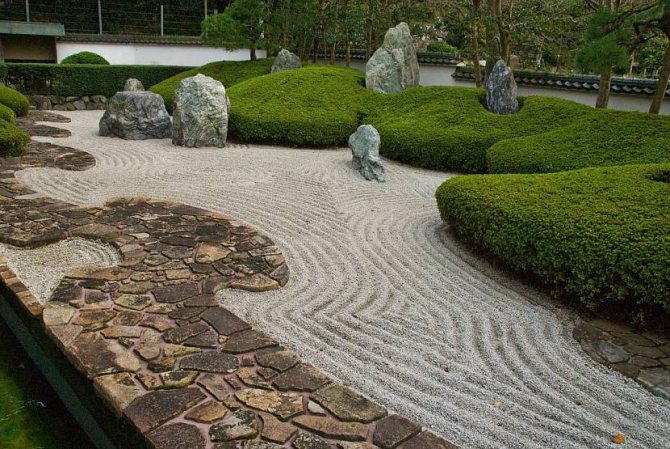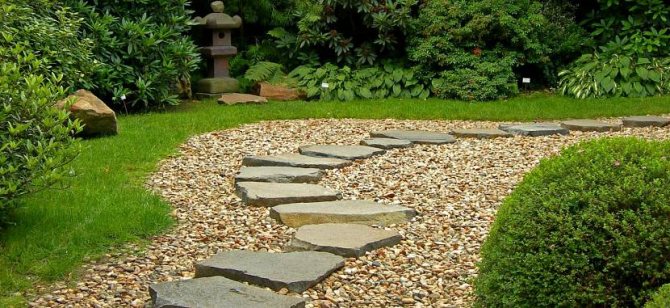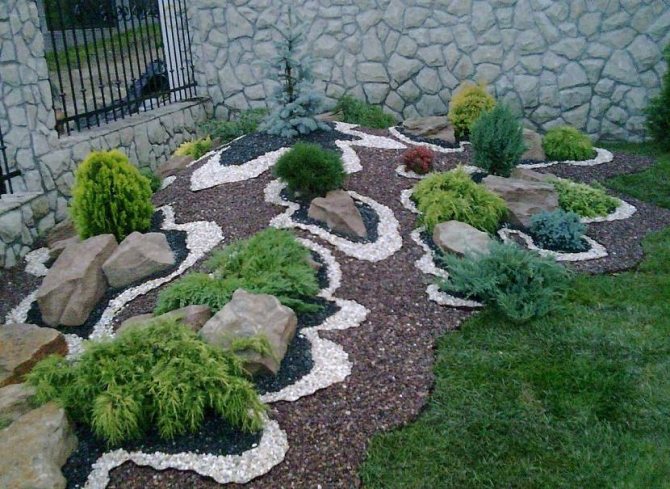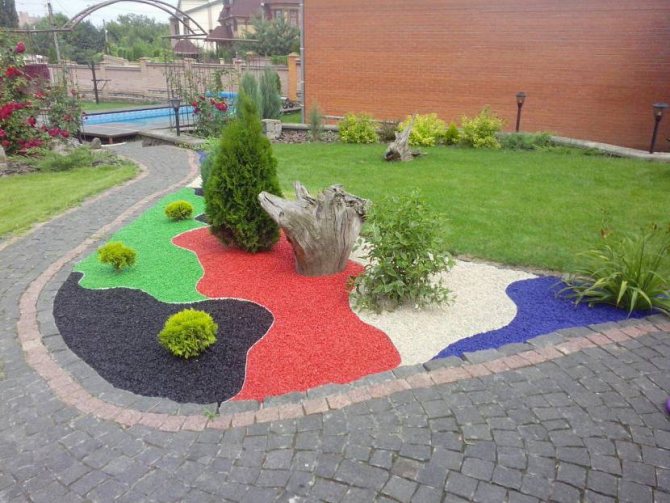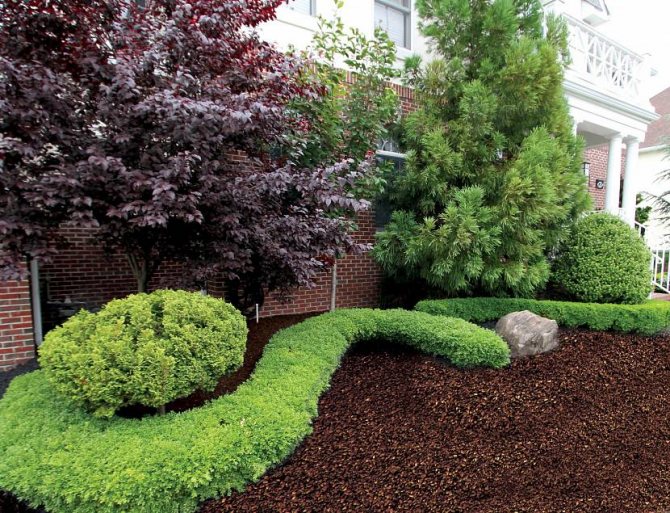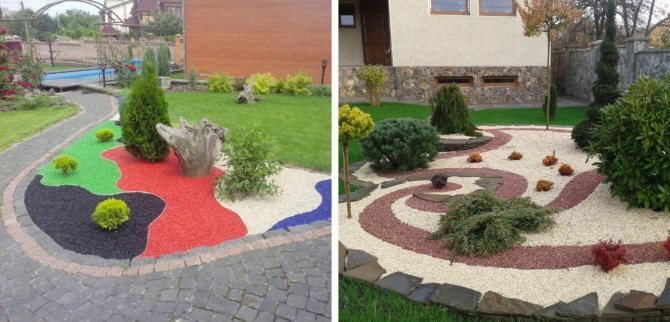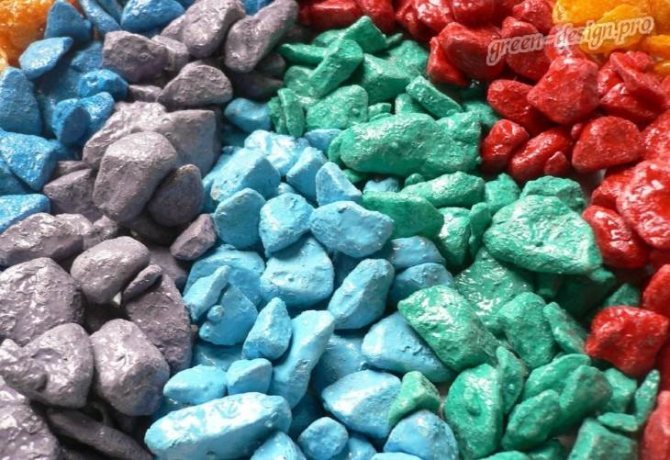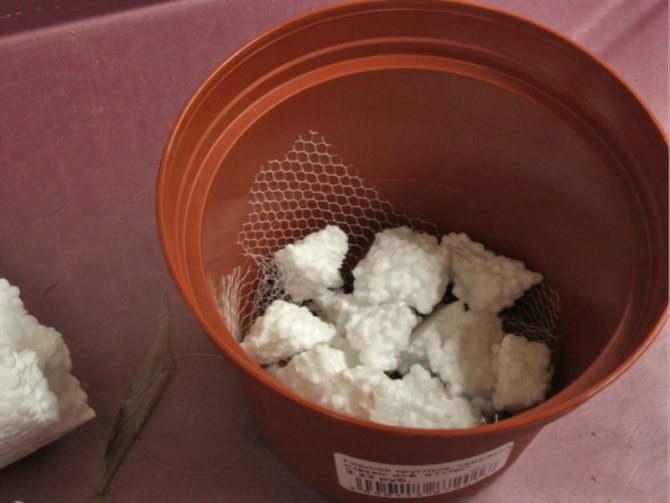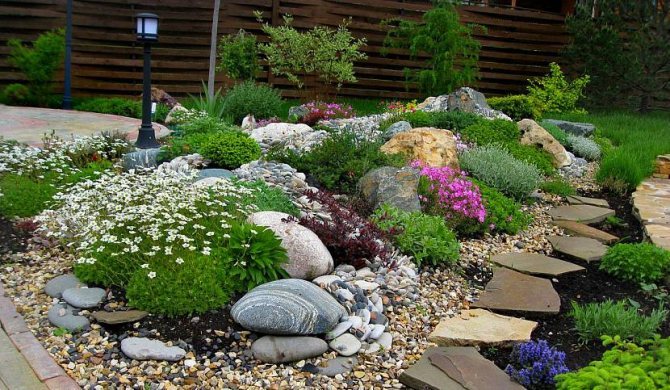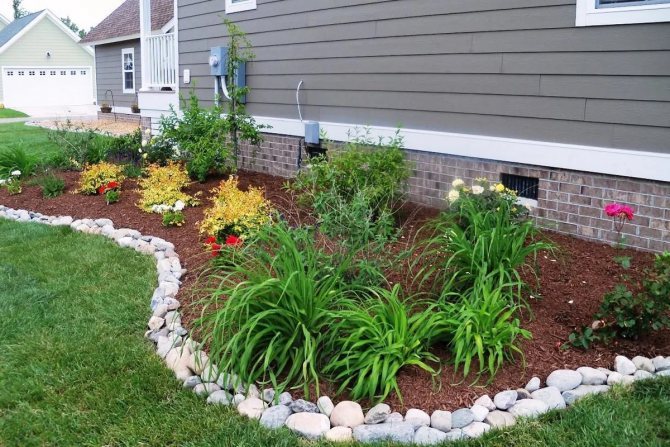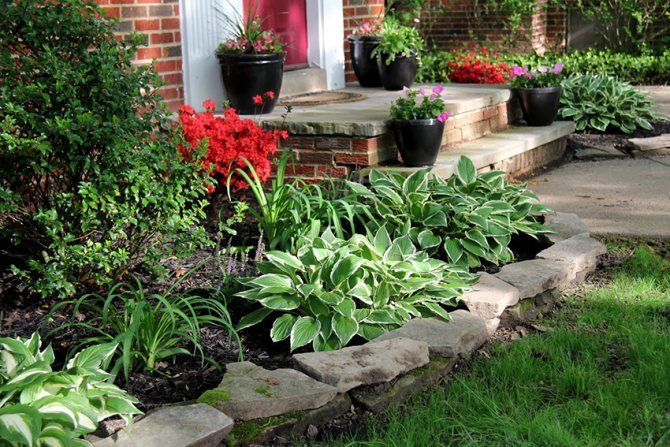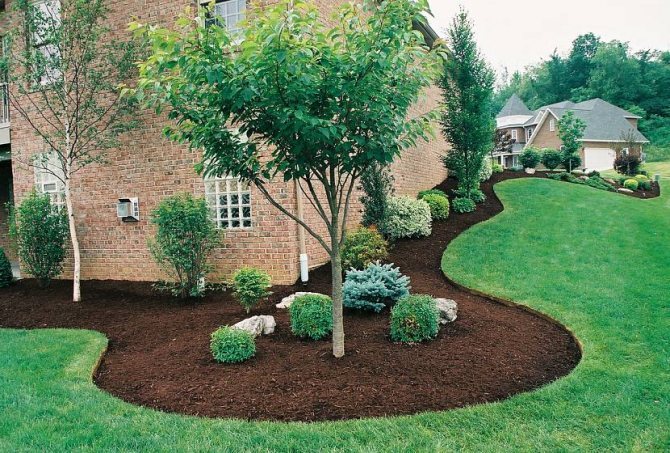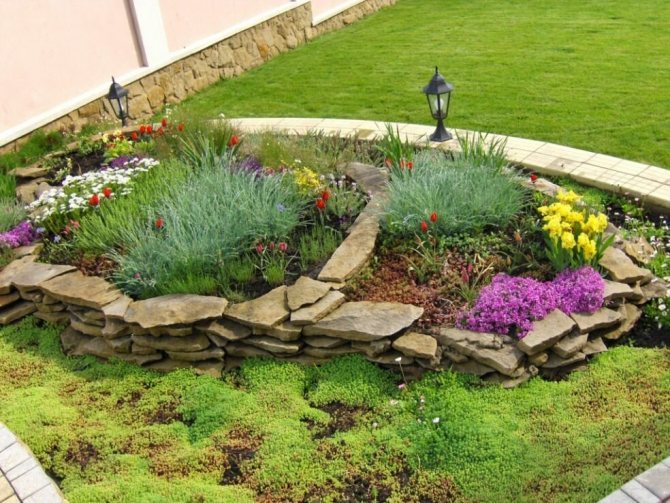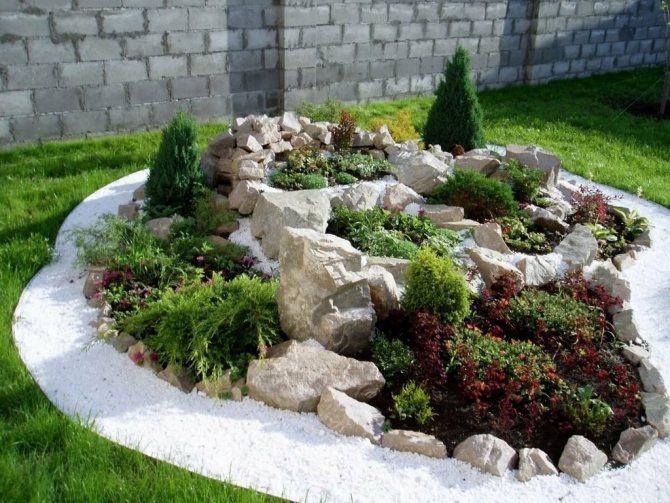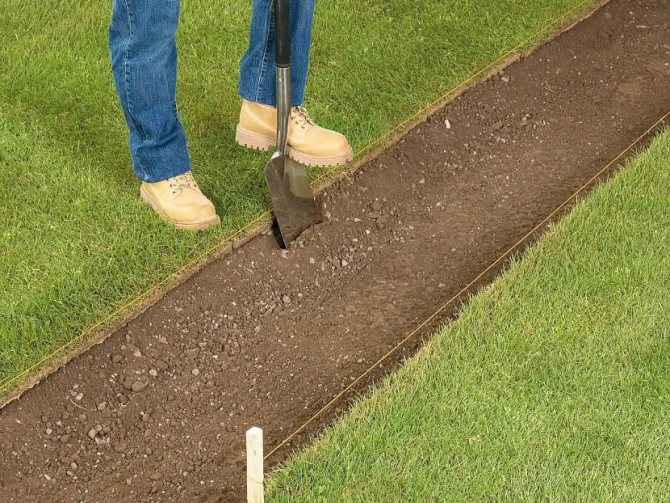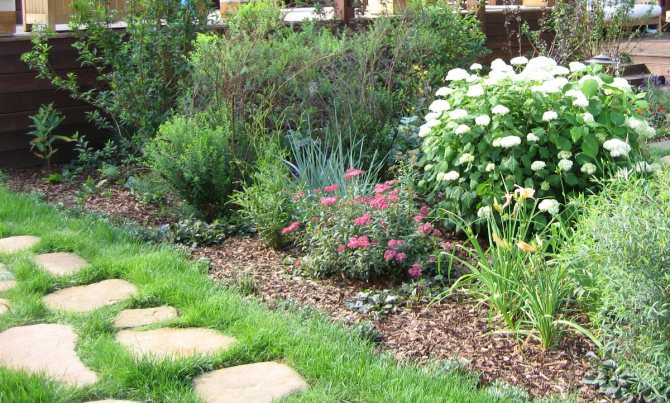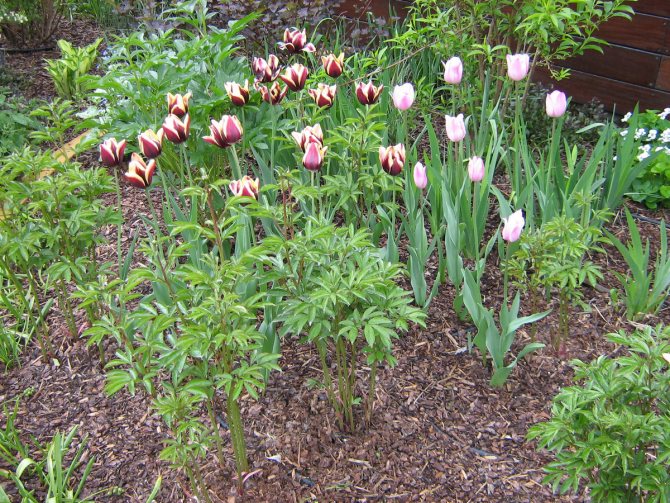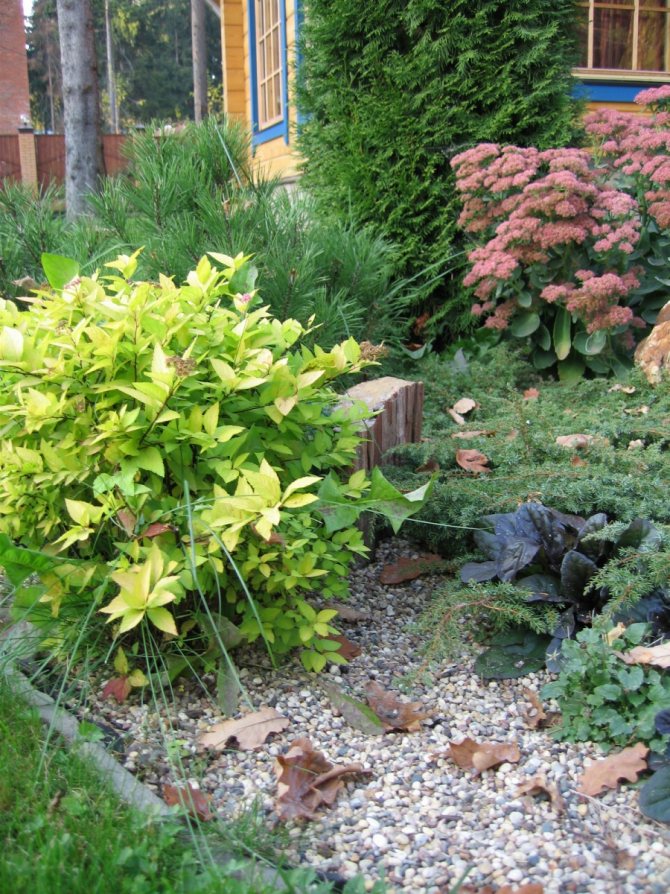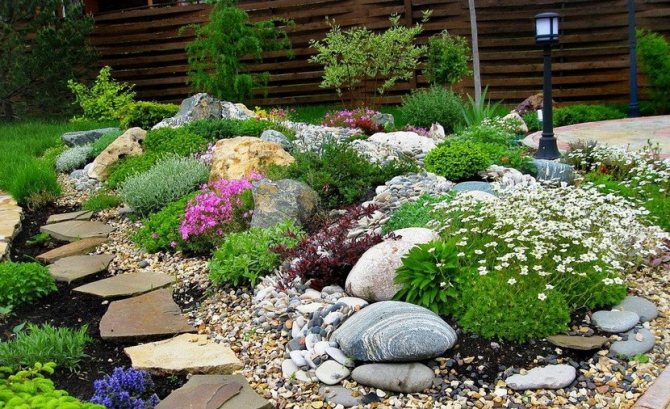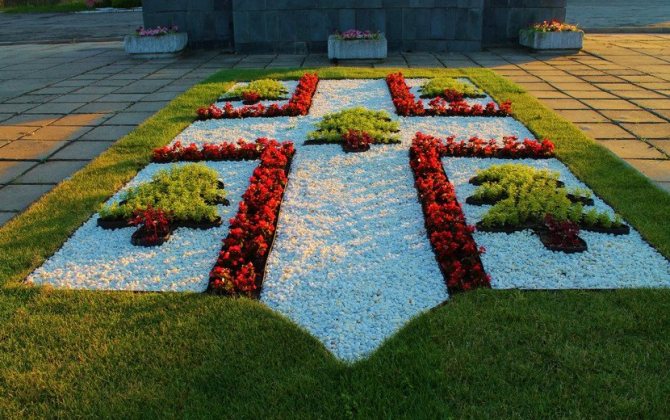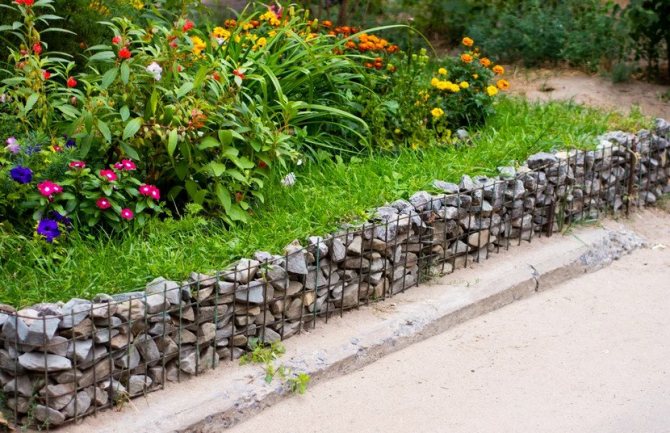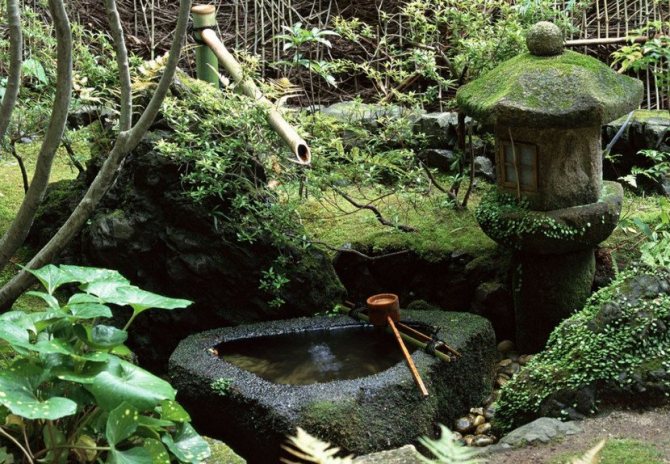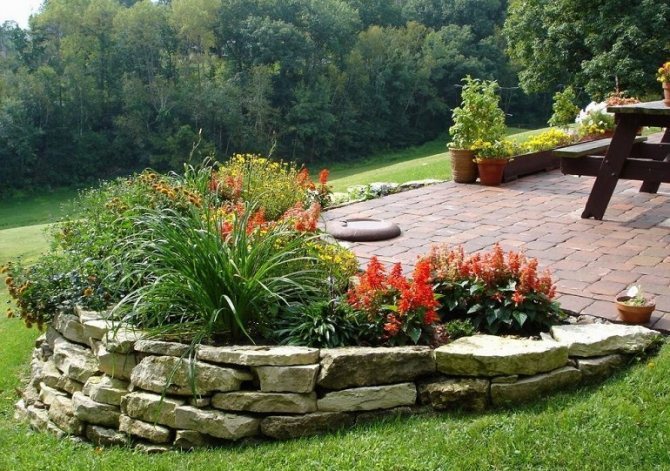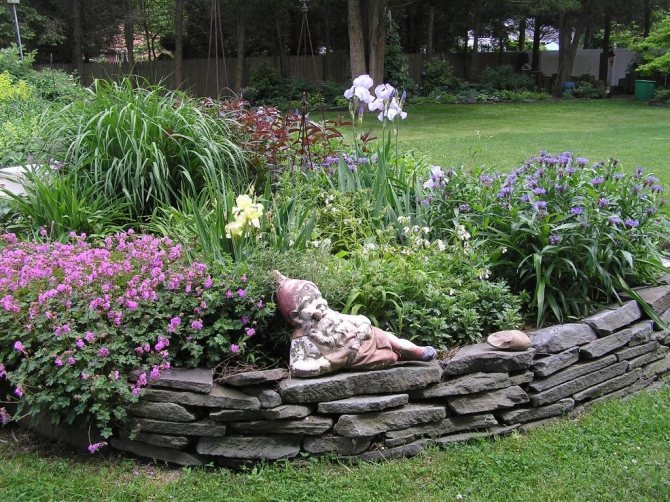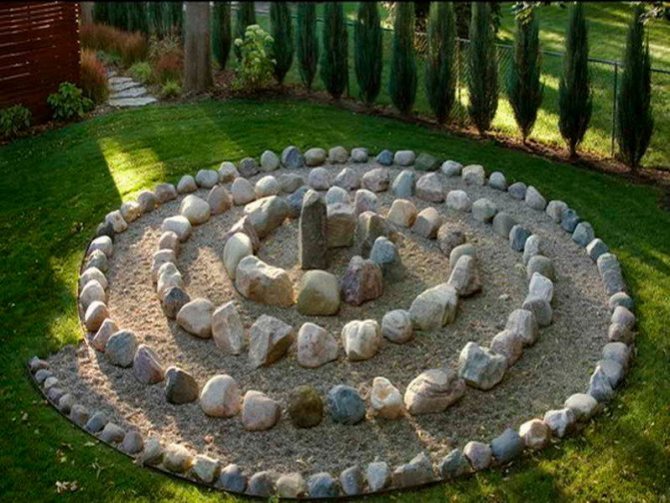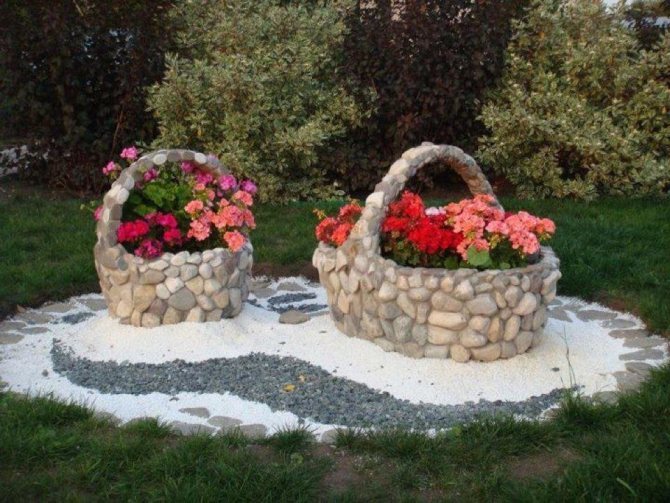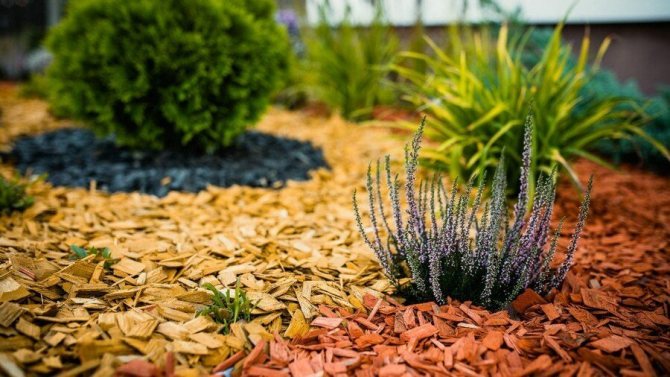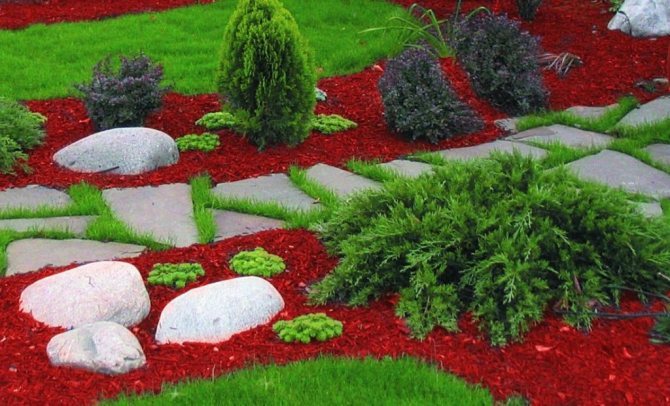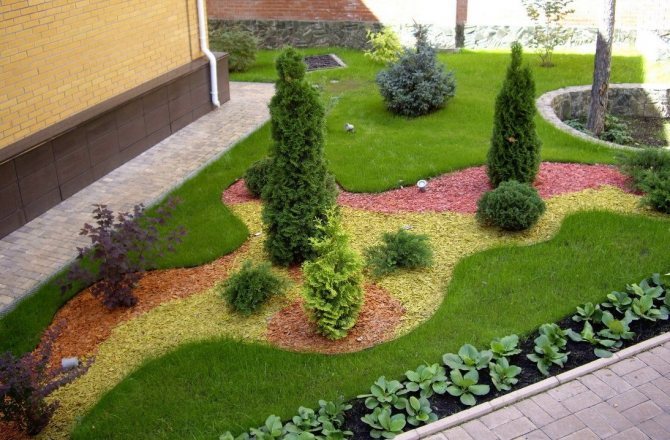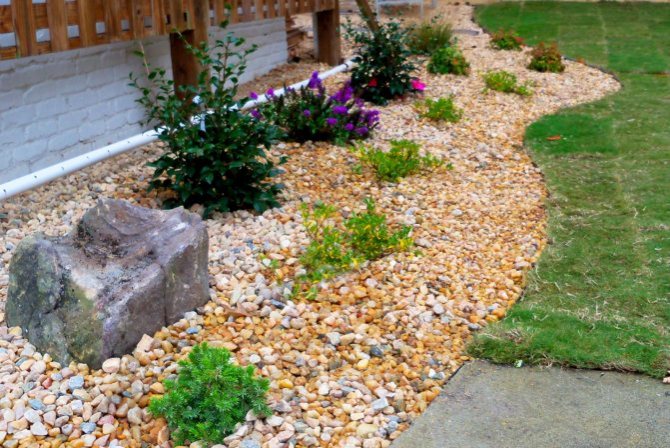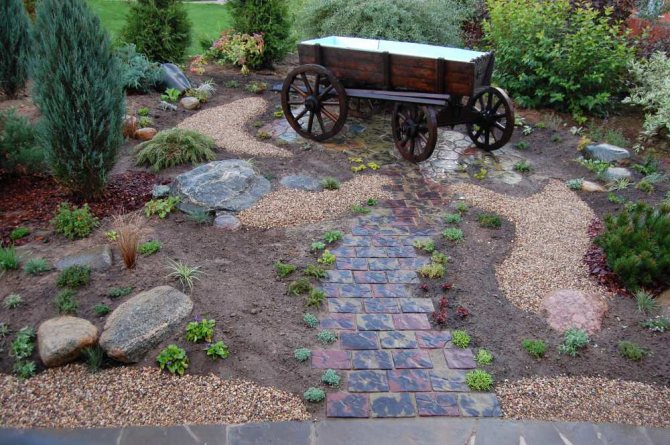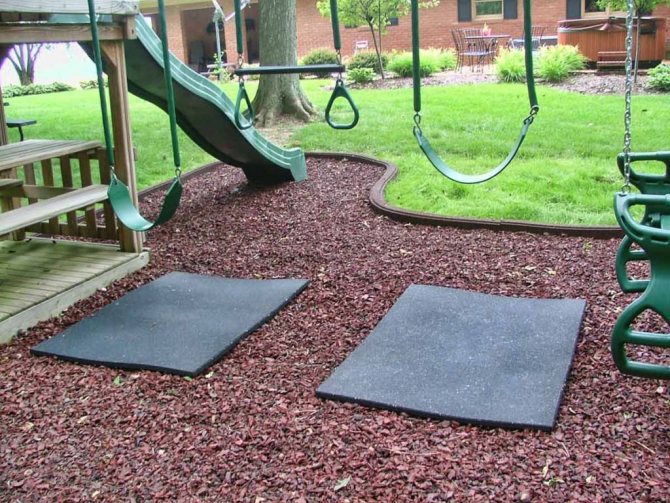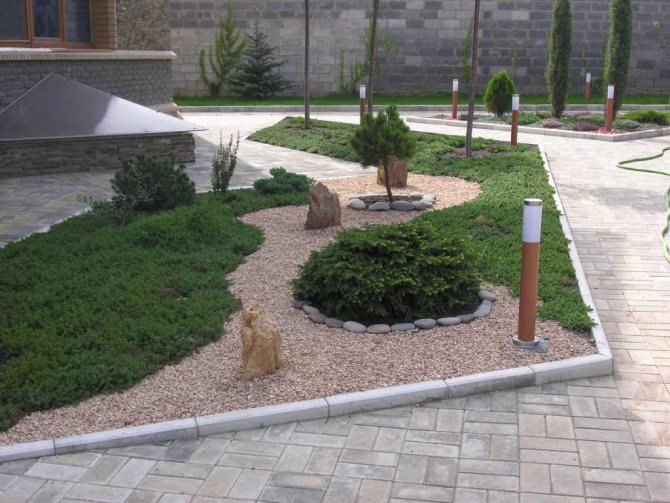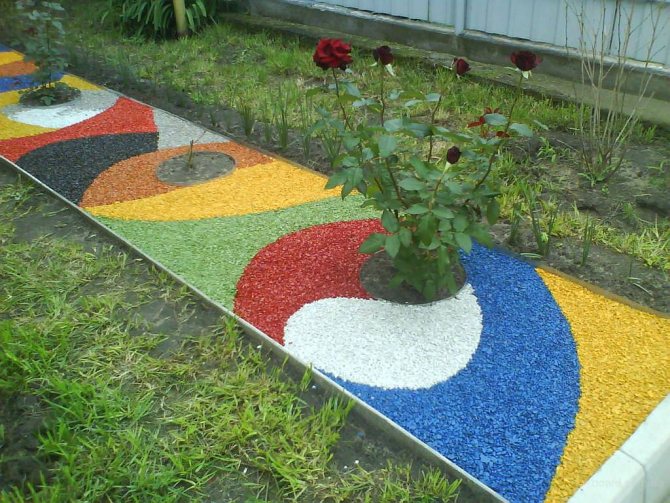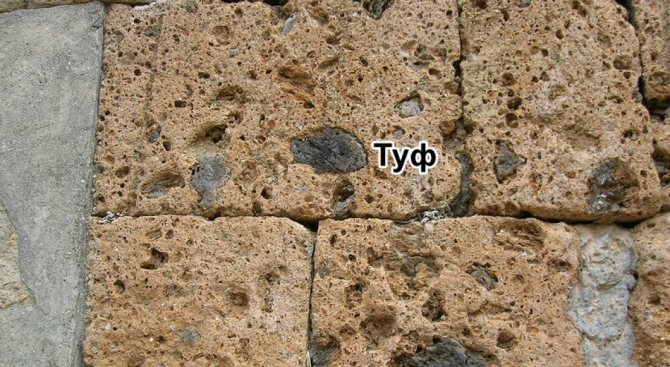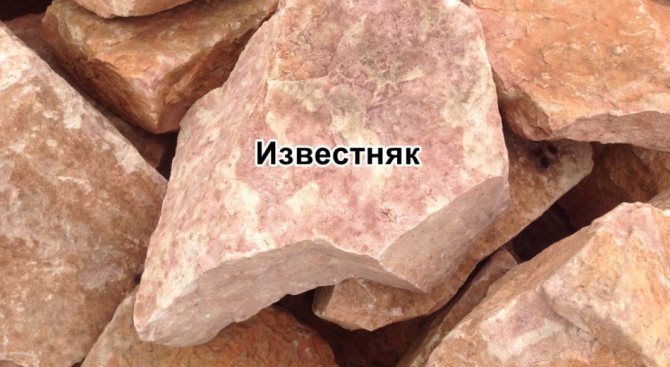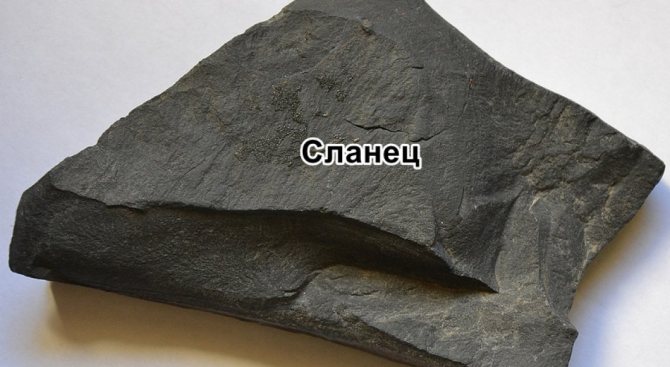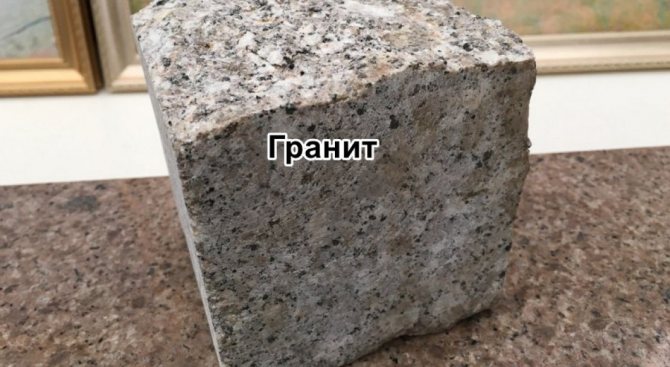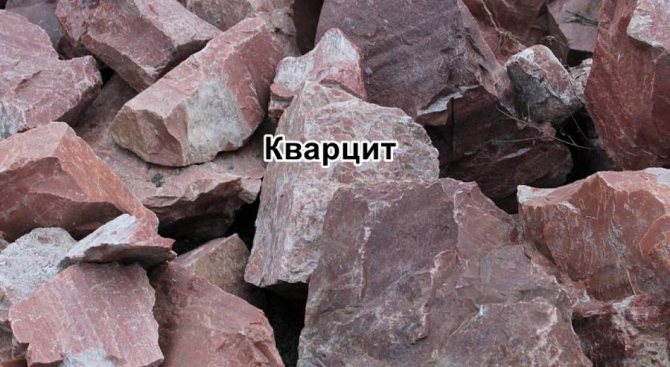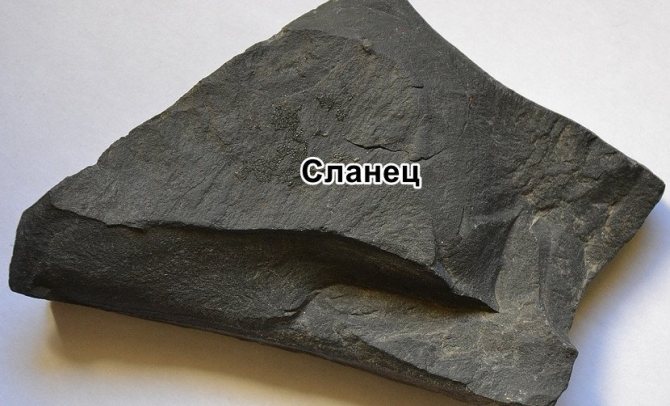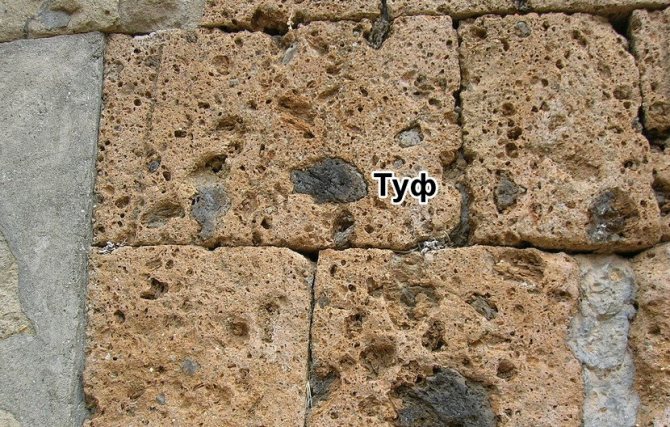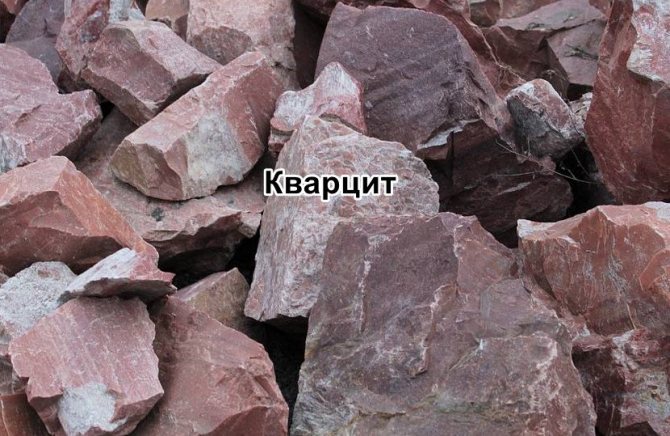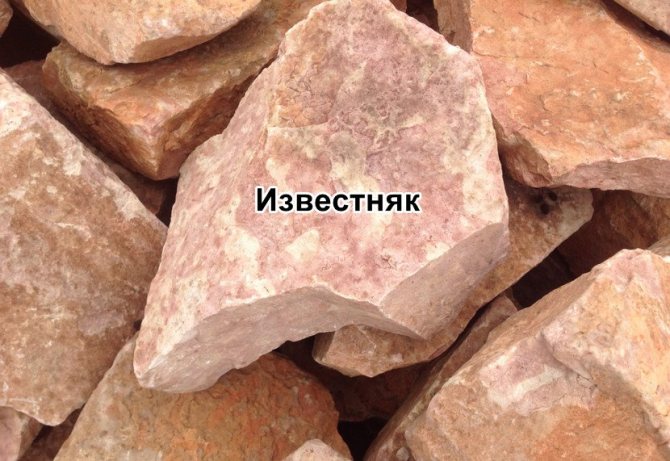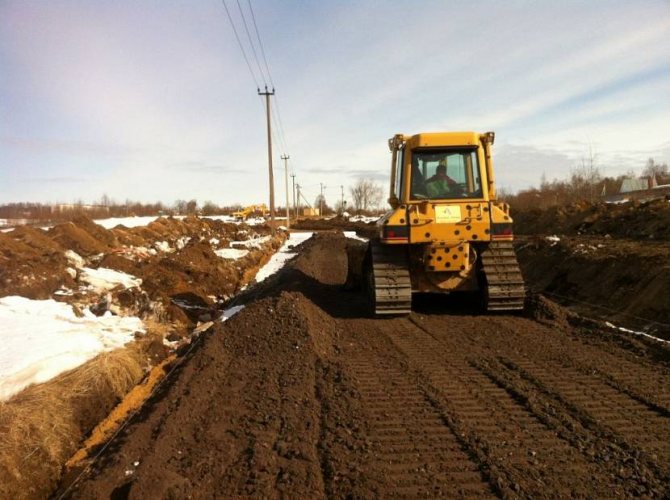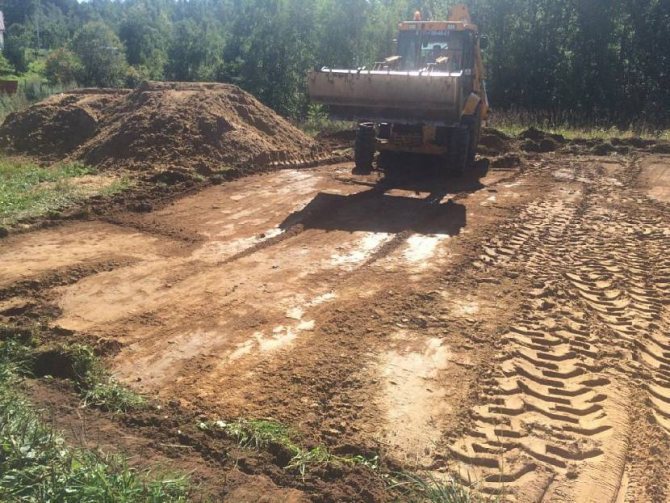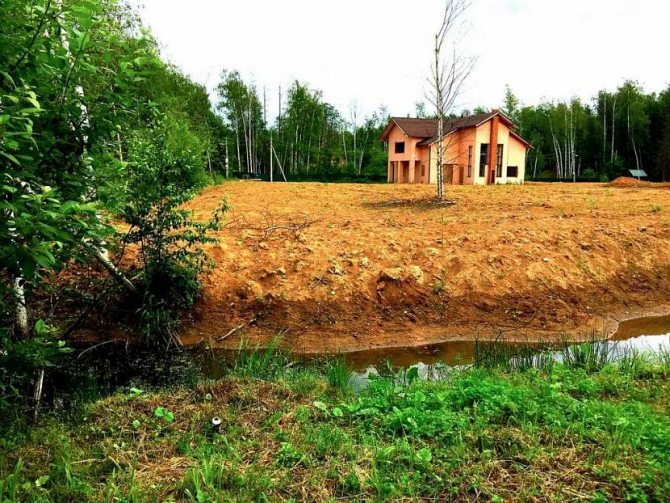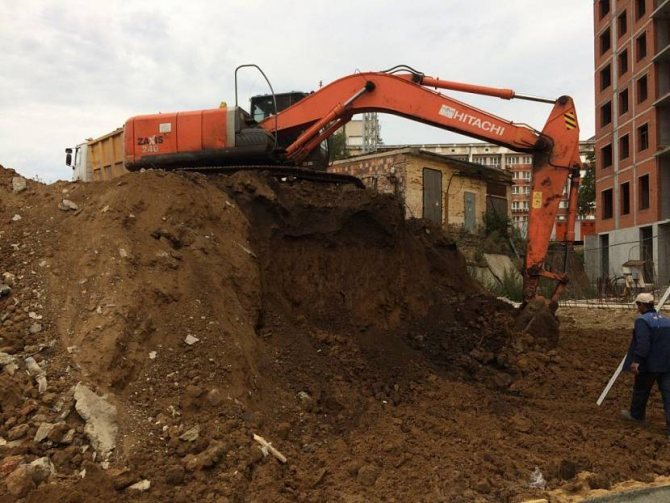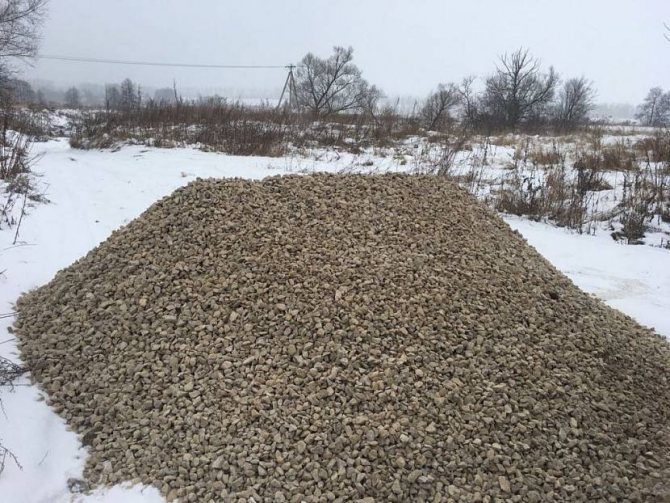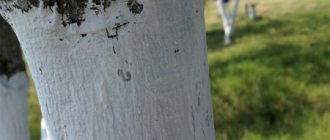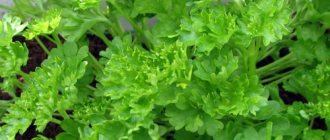The use of various decorative fillings in the landscape design of the site can completely transform the appearance of your property. A number of decorative compositions - Japanese "dry" landscape, rock garden or rockery, sandy garden, landscape pond - are practically unthinkable without some kind of dumping. In addition, they can be used to create paths and patios, and for decorating flower beds, and for many other purposes.
Mulching the soil under the plants protects it from excessive moisture evaporation. And using colored decorative chips in the garden, multi-colored glass, dumping with rubble of various fractions and shades, you can achieve absolutely extraordinary effects.
What does it mean - "decorative crushed stone"
This is crushed stone of a cubic shape of a fine fraction (10-15 mm), painted with bright colors. Industrial enterprises use a coloring pigment that is resistant to external factors and at the same time non-toxic, absolutely harmless to soil and plants. Therefore, without a shadow of a doubt, use it on garden beds, playgrounds, for artistically designed inscriptions on the ground, framing monuments, as well as to create a bright bottom and coast not only in reservoirs, but also in artificially created streams and ponds. Decorative painted crushed stone used for landscaping, resistant to frost and sunlight. Be sure, before purchasing rubble, pay attention to the radioactive indicators. Crushed stone of the first class of radioactivity is suitable for ennobling children's, park grounds, and backyard paths, and the second is used only in construction.
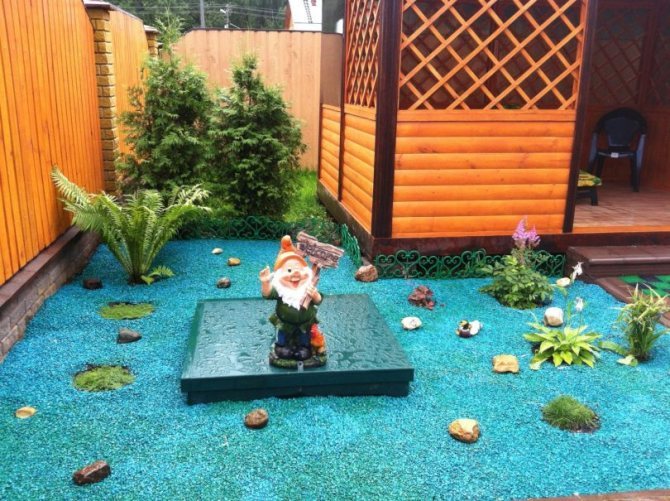
Colored crushed stone in design
How you can use gravel in your garden
Working with gravel is easy. You get a quick, durable result and the embodiment of your ideas. In the garden, tree trunks and large shrubs are most often decorated. This procedure helps to retain moisture in the soil, is a mulch layer and decorates the garden. Garden paths or loose curbs between the garden path and the lawn are also made from gravel.Medium-sized stones accentuate large objects in the landscape, for example, framing fountains or statues, wells or curly flower beds.
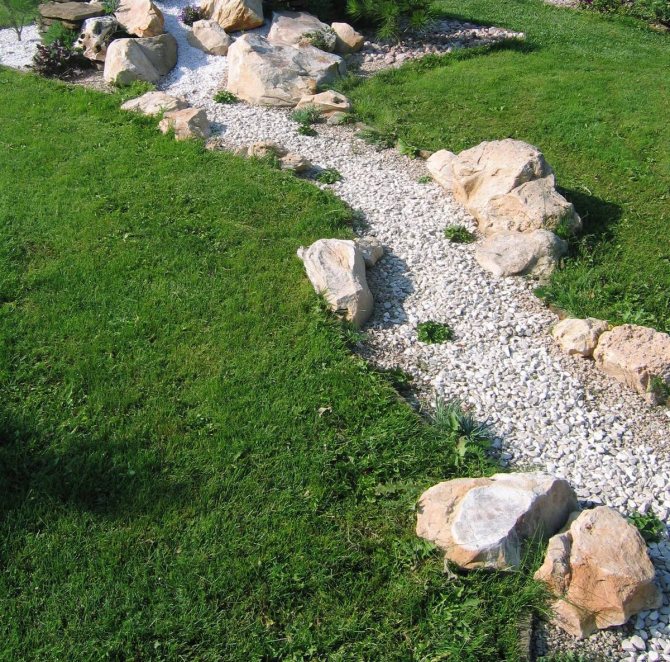

Creating a gravel garden
Before you start creating a gravel garden, you should create a sketch and choose the right site. On the sketch, use colored pencils to indicate where the plants will be planted and draw a pattern of colored stones. After choosing a site, it is carefully cleaned and treated with special preparations for gravel gardens. Then drainage is done and the base is tamped. The place where you plan to cover the gravel layer is covered with geotextile underlayment or foil and secured with metal staples. It should be borne in mind that the area covered with geotextile film should be larger in size than the planned gravel garden itself.
Find plants that are easy to care for and decorative in appearance and plant them in a gravel garden. Such plants can be saxifrage, bergenia, yarrow, phlox, tsyan and others. A beautiful cover can be made using subulate phlox and large stones. By planting stonecrop, you will decorate the garden all year round. Stonecrops are often used in gravel gardens due to the variety of their types, colors, which can be combined with stones of different colors. The bright flowers of stonecrop contrast beautifully on the evergreen crown. A no less popular plant in the gravel garden is the kokoryshilistnaya Volzhanka, which has medium-sized openwork leaves. They are able to maintain their beautiful appearance throughout the season. Small pinkish flowers, the darkness of lemon-scented flowers will give your garden not only beauty, but also a delicate aroma. Don't forget to plant undersized shrubs that look great against gravel. These include shrub cinquefoil, holly mahonia and Japanese spirea. The leaves of these plants retain their beauty until late autumn.
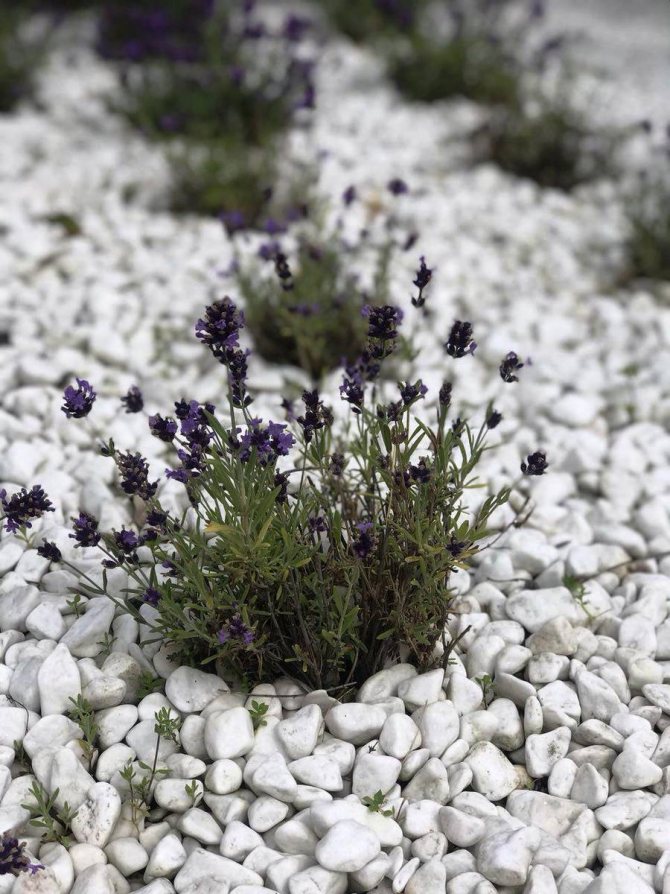

Two in one: the use of stone for mulching
If the stone is filled with a layer of 5–10 cm, it, in addition to the decorative role, will perfectly cope with the mulching function. And this, in turn, will have a beneficial effect on the condition of green spaces and facilitate their care.
What is the use of stone filling as mulch?
- It helps to retain moisture.
- Protects the topsoil from excessive compaction.
- Protects the plant root system from overheating.
- Suppresses the germination of weeds.
Even in the case when crushed stone is applied to the geofabric, due to the water permeability of the latter, it fully performs the function of mulching.
Drought-resistant plants do not like too moist and dense soil. To enhance its drainage properties, mix the top layer about the size of a shovel's bayonet with fine gravel. Cover the surface with rubble.
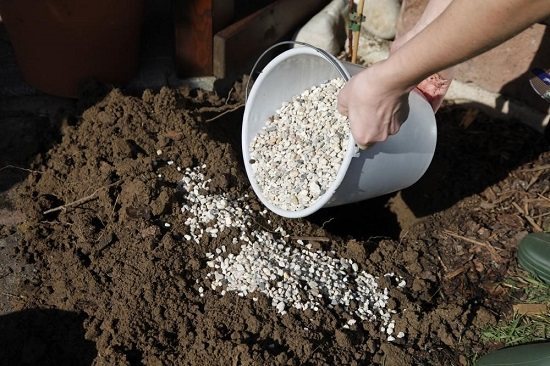

Using gravel as drainage
Easy to clean and practical
The gravel coating does not require much maintenance. You will only need to make every effort in the process of forming a gravel garden. Working with this material does not require special skills and abilities. You just need to connect your imagination and stock up on various types of gravel. It is very simple to take care of gravel gardens: you just need to make sure that its edges are not "washed out", remove weeds if they occur, and periodically wash the pebbles.
Recently, reservoirs on the site have become very popular, but some gardeners cannot afford this. The reasons may be: the small size of the site, its location or a financial deficit. A gravel embankment will help you to recreate the image of a stream. By mixing blue and blue gravel of different sizes, you get a good imitation of a pond. With the help of pebbles, you can make a picture of a seascape, a desert or an erupting volcano.Feel free to use various handy tools in the creative process, such as shells, plastic bottles, polished glass from beer and wine bottles, or pieces of plastic. By combining them with each other, you will get a result that exceeds any imagination.
DIY multicolored crushed stone - staining technology
What crushed stone is suitable for staining
Granite, marble, limestone - three types of crushed stone that are available to the inhabitants of our country. Granite and marble stones lend themselves better to staining. Calcareous, due to enhanced chalking, is not subject to high-quality staining.
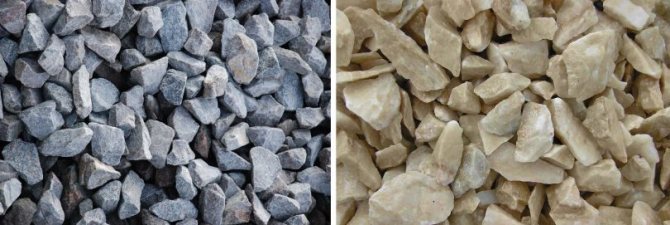

Crushed granite and marble
What size stone should be for the best coloration
The stone should be the same size, within 10-15 mm. If the stone is of different sizes, you will need a small mesh metal mesh for "sifting". Fasten the metal mesh on both sides and pull it at an angle, somewhere around 60 degrees, for better sifting. Pour stone onto the mesh. Small fractions will fall through the cells under the grid, and larger fractions will roll down it. Do not try to measure out crushed stone to a millimeter. The main thing is to get rid of large stones.
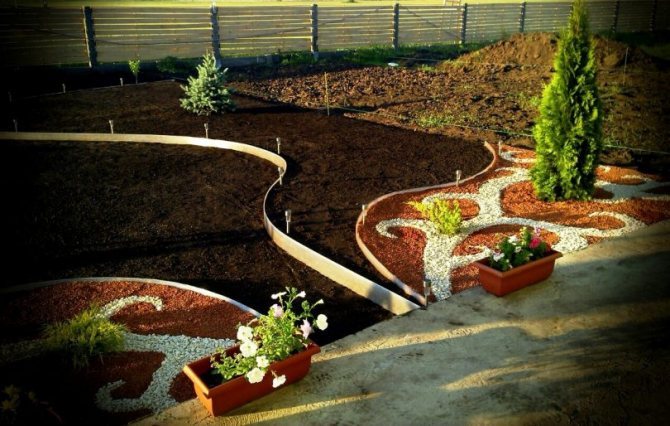

Gravel decoration
How to paint rubble at home and with what paint
Be sure to rinse the crushed stone before painting. To do this, fill the stone on the same metal mesh in batches and dip it into a container with water. We pour the washed crushed stone onto the ground, after laying the old linoleum, oilcloth or sheet of metal, for drying for 0.5-1 hour. Acrylic and water-based paints are suitable for staining. If you have a concrete mixer, use it. Pour the dried crushed stone into a concrete mixer, pour the paint in several passes, depending on the desired color saturation. If no mixer is available, use spray paint. Having pulled out of the concrete mixer, the painted crushed stone must be dried. Allow excess paint to drain on a metal mesh. Place a tray for paint under the net. The same paint as glass can be applied in subsequent painting. Colored crushed stone will retain brightness and color saturation if you use a high-quality dye and adhere to the dyeing technology.
Crushed stone staining (video)
Additional tips, recommendations
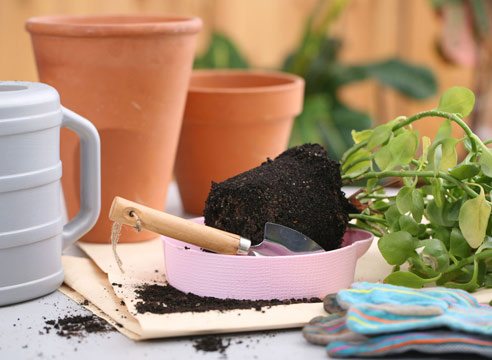

Home flowers, like the florist himself, do not always care what kind of drainage you use. Therefore, when choosing it, you need to be guided by both your preferences and the needs of the plants. In this regard, you should heed the following recommendations:
- If accessibility is the main thing for you, then give preference to polystyrene, cork, ceramic fragments or bricks (whatever comes to hand). You can even use old rocks from the aquarium or walnut shells.
- If drainage quality, safety and accessibility are equally important, then it is better to choose expanded clay, crushed stone or gravel.
- If the flower is prone to root rot (or you often overflow the soil), then choose charcoal or sphagnum.
- If you do not like unnecessary actions (grinding material, disinfecting), buy perlite or vermiculite.
- If the aboveground part of the plant is very massive, and the root system is shallow, then heavy drainage will help to give stability to the pot. In this case, crushed stone or gravel will do.
Whatever material you choose for the construction of the drainage layer, it should be quite large. The diameter of the individual pebbles should be about 2 cm. Larger sizes are acceptable if for some reason you planted the flower in a pot without drainage holes. In any case, you must make sure that all stones are free from sharp corners and edges. Otherwise, they need to be sharpened to prevent root damage.
Where decorative crushed stone is used
- Picturesque drawings on flower beds, flower beds, between fruit trees, paths in personal plots or garden and park areas.
- In the design on flower beds, footpaths of the original inscriptions.
- Blind area around a residential building and outbuildings, areas around the pool.
- Paths in playgrounds.
- The boundary of the shore of the reservoir, the bottom of the pond.
- Framing obelisks, monuments.
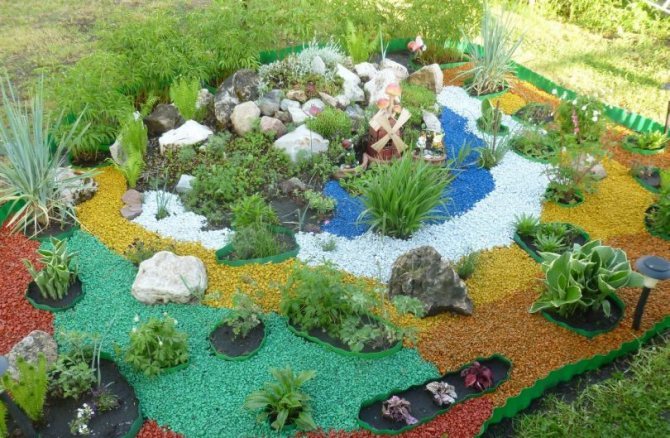

Alpine slide with rubble The photo shows examples of the use of decorative rubble in landscape design
Styling and care features
Laying decorative soil should begin with drawing up a plan for its placement. It will help you understand what the expense will be, where the coverage areas will be located. Then the plot is marked according to the planned plan. To do this, pegs are driven into the ground, threads are pulled between them.
The territory inside the marking is cleared of debris and weeds. Sod is removed from above, a trench is formed to the depth of dumping (usually its thickness is 7 cm). Geotextile or polyethylene film is laid at the bottom. If it is used, holes need to be made on its surface. They will allow excess moisture to go into the ground. This will help prevent the formation of silt on the surface of the stone fractions.


Layout for filling tracks Source lipeck.
If you plan to plant plants inside, this is done at this stage: a hole of the required diameter is made in the film, a hole is dug under it, seedlings are planted in it. At the final stage, the main material is filled up. With this installation, gravel bedding in landscape design will last a very long time. She will perform all her functions. But you still have to take care of her periodically. For this you need:
- weeding plants;
- clean the surface from weedy debris;
- add the main material if necessary.
Types of flower beds
- Arabesque. The flower bed has an unusual shape, for example, butterfly wings. For planting, use low plants, shaped like a carpet. Placement in a flower bed is done according to the principle of symmetry.
- Rockery. This is a large stone of various shapes of one type. They are placed in the ground to give stability to the flower bed. Nearby everything is sprinkled with small pebbles. Plantings of low bushes, juniper plants, dwarf spruce, miscanthus look good here.
- Japanese style garden plot. Round stones with moss growths are placed at a distance from each other. Mostly boulders and pebbles are used in this design. Planting plants is done in small portions.
- Gabion. The structure is a grid where small stones are poured. The advantage of this flower bed is any shape and size. The flower garden is environmentally friendly, durable, has good drainage for the soil and will cost the owner of the site a small amount.
Step by step creation of a gravel masterpiece
The order of work is as follows:
- The first step is to choose a placewhere you would like to arrange your garden. If there is not much space on the site, it can be created even on an area of 1-1.5 sq.m.
- We carry out cost calculations and prepare materials.
- After the site is selected and the materials are purchased, you need to prepare the ground. Sandy soil is most convenient for creating such a garden, although it can be done anywhere. The site needs to be marked out, marking its boundaries - drive in the pegs, pull the rope. Then a 10-15 cm layer of soil is removed from the soil. Particular attention should be paid to the removal of weeds along with the roots. Weeds are usually the main problem in gravel garden maintenance. After the soil layer and weeds are removed, the pit with moistened soil is left for 7-10 days, during which time the roots of the weeds will grow and they can be removed completely.
- Then the site needs to be dugby adding loosening agents to the soil - vermiculite, expanded clay sand, coarse sand.Thus, you will drain the soil so that excess moisture is removed from the roots of plants, which will then be planted in this area. Organic fertilizers, peat can be added to the soil so that the planted plants will take root and grow well.
- The soil needs to be compacted a little and covered with geotextiles. Geotextiles will prevent weeds from germinating, as well as keep the gravel layer from subsiding.
- Now you can add gravel. There are two options here: to plant the plants, and then fill up a layer of gravel or rubble, or first make a backfill and then plant the plants. The first option seems to be more convenient, although many choose the second option. Garden gravel isn't the only material you can use. Pebbles are also suitable for such a garden, its rounded shape and grayish color will look good against the background of the lawns surrounding the garden. Large stones are not used when creating a gravel garden.
- Creation of dividing borders. Curbs will help preserve the boundaries of the garden, otherwise the roots of other plants will eventually penetrate the site, and the gravel border will be washed out by rain.
- Planting plants. If you decide to plant the plants after backfilling the gravel, you need to rake out the gravel layer in the designated places, make a hole in the agrofibre, depressions, and plant the plant. Then remove unnecessary pieces of agrofibre, and gently level the gravel.
This is how it all looks:


This is an example of calculating the cost of a gravel site, the prices are quite relevant. Most likely, you will not need to use geogrids - only if you will be doing work on the slope
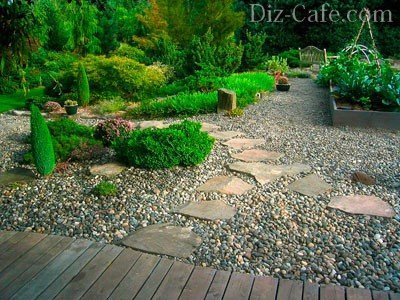

Pebbles are a good choice for a gravel garden. In this case, a stone path was made on top of the main covering and a boardwalk was laid to make it easier to move around the garden.
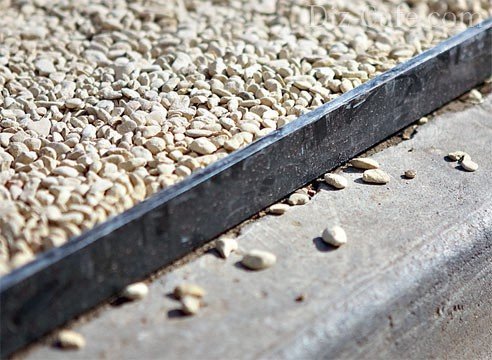

The curb can be made of plastic, iron, brick, or use a curbstone
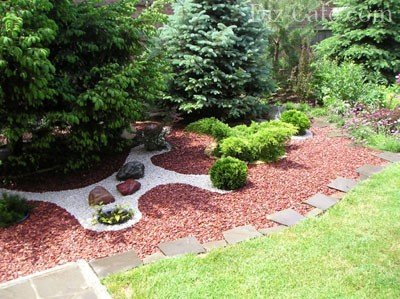

To decorate the garden, you can use both gray gravel and multi-colored. Effective patterns are created using two colors
Rules for laying decorative gravel
Gravel for landscaping can be easily laid with your own hands. But in this work, you need to adhere to certain rules.
- Delineate the place where the rubble is laid. Prepare the area for laying gravel: remove, excavate, approximately 10 cm of the top layer of soil in the place of filling the material.
- Set up curbs. Regardless of what shape your path in the garden will be - straight or ornate - install a fence, curbs. Brick, natural stone of the same size, wooden, plastic or metal canvases can be used as a border. The fence must be secure and not wobbly. To do this, you need to dig the fence into the ground.
- Prepare the base. Pour sand, the layer of which is at least 5 cm, into the prepared trench. Pour water over the sand layer for better shrinkage. Pre-level it over the entire area. When the sand is dry, lay an insulating material - plastic wrap with plenty of holes for water outflow. During precipitation or watering, water will not linger on the film, but will flow freely through the holes into the soil. The top layer of sand is poured onto the plastic wrap, already 2-3 cm.
- Prepare a stencil. If you decide to create a multi-colored composition, you will need internal borders to separate the color and form any geometric patterns. Thanks to the borders, the stone will not mix with each other.
- Laying colored gravel. After you have prepared the base, you need to evenly fill in the decorative stone. For a lawn or flower bed, a small layer is enough, 2 cm, and for playgrounds, paths for pedestrians or cyclists - at least 4-6 cm.
Step-by-Step Guide to Gravel Dumping (Video)
Benefits of gravel
- The main advantage of this material is its environmental friendliness.... They do not in any way affect the moisture absorption and respiration of the soil, contributes to the better development of the root system in plants, is a means for mulching, as it is able to keep the soil cool in hot weather. Fine gravel is used as a loosening agent on dense clayey soils. This facilitates the planting of any plants on this type of soil.
- The second advantage of gravel is its decorative appearance. It successfully replaces grassy lawns or paving slabs. Properly selected gravel can set off the beauty of the plants in the garden, highlighting and complementing them. The gravel layer is practically not exposed to the external environment and has a decorative appearance in any weather and season. Shaded areas where plants do not want to grow can be decorated with gravel flooring of different colors, making it in the form of a composition, which will decorate this area without using plants.
- Gravel comes in different colors and sizes... When creating a gravel composition, use those different sizes of stones. It can be from 5 mm to 8 cm. By combining different sizes and colors, you can make beautiful compositions. It can be combined with any plants or decor materials. It is in perfect harmony with large stones and trees, moss and glass, concrete and metal. Using these materials, you can create paintings and patterns that amaze any imagination.
- Gravel can be used to decorate problem areas of your site, such as holes of different sizes and shapes, hills or cellars. The gravel lawn does not require mowing, watering and special maintenance. The most difficult part of your garden can be turned into a work of art using moss or fern along with large stones and gravel of different sizes.
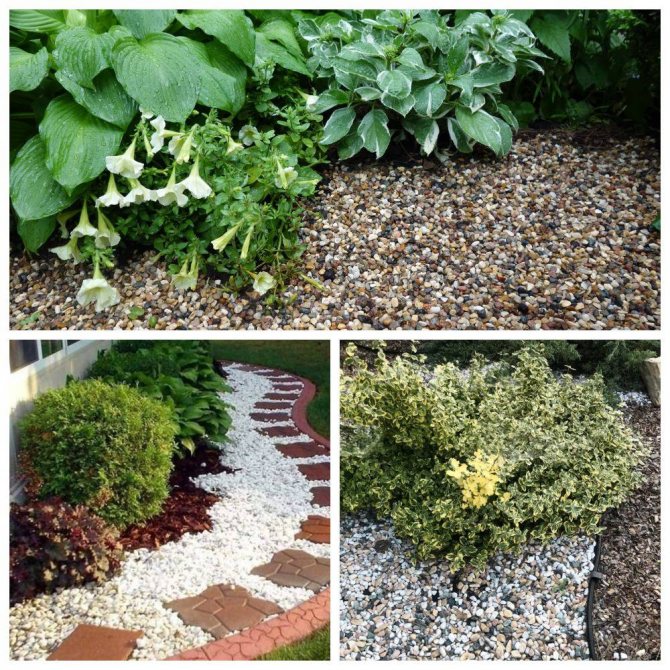

Decorative stone filling: features, pros and cons
Decorative backfill is a special type of covering made of bulk materials of different origin, fraction, color, widely used for garden decoration. It simultaneously performs several functions:
- enhances the aesthetic appeal of garden compositions;
- protects the topsoil from compaction, overheating, drying out;
- simplifies the care of flower beds.
Especially interesting looks inorganic filling with decorative stone - crushed stone, gravel, pebbles. Popular rocks include marble, granite, gneiss, serpentinite. Natural unpainted material has many advantages.
- It is durable.
- Unlike organic matter, it does not rot.
- Does not fade in the sun and retains its attractive appearance for years.
- Doesn't require much maintenance.
- Copes with the mulching function.
The disadvantages of such a dump include the fact that weeds germinate through it, and also difficulties arise when harvesting fallen leaves in the fall. But these problems can be avoided if the installation of the stone filling is done correctly.
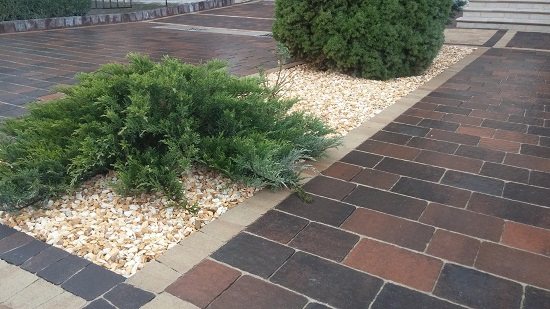

Decorative filling with marble crushed stone
Gravel care
Caring for gravel dumps is very simple - just remove fallen leaves and sprouted weeds.
It is best to remove the leaves with a garden vacuum cleaner, not allowing them to "seep" between the stones. Otherwise, decayed leaves can be an excellent breeding ground for weeds.
Over time, of course, the weeds will try to settle in the gravel bed. We remove them mechanically or use a concentrated solution of a broad-spectrum herbicide.


Summer resident lunar calendar for April 2015
Previous post


Garden health. The main pests of berry bushes
Next post
How land plots are classified
The procedure for raising the earth with your own hands depends on the type of site.
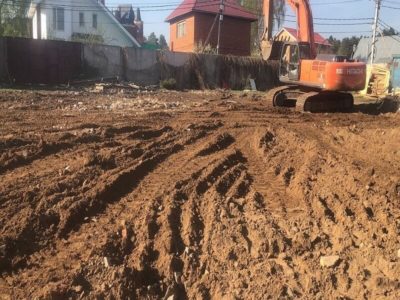

They are divided on the basis of the landscape, the characteristics of the geological structure:
- Above sea level. They are located mainly in the mountains, on natural plains. The regions are characterized by frequent precipitation and low temperatures.The type of soil is different, geological studies are carried out before the rise of the land plot.
- Below. They are located in the lowlands, swamps. The nature of the soil is different, fertile is found. If it is decided to erect a building so as not to flood it, the earth is raised.
- Above ground level. It has bumpy reliefs, depressions that complicate processing. The flaw will correct the uplift.
- Below. Located in lowlands where water flows. To prevent the formation of a swamp, the territory is backfilled.
For leveling, use rubble, clay, sand and other material.
Gravel
Unlike the above-mentioned building material, gravel is a product of natural influences. Separate open layers and rocks are exposed to weathering, gradually collapsing and crumbling. Gravel grains are collected by special mechanisms. In the process, it is sieved, sometimes washed, cleaned of foreign particles - clay, sand, soil. Further, as in the version with crushed stone, work is underway to crush large pieces and sort into fractions. Gravel can also be not only mountain - it is mined in rivers, seas, lakes. In general, gravel has a rounded smooth shape that is more attractive than crushed stone. But, river or sea has a very smooth shape, therefore it does not have the necessary adhesion to the cement-sand mass in the solution, it immediately settles to the bottom. Thus, the reliability and strength of the concrete mass is violated, the base of the structure will not withstand the loads, it will crack and collapse. In construction work, rock gravel is used more, it has a slight roughness. It is also used as crushed stone - road construction, foundations of low buildings, concrete products. Due to its flat shape and rounded edges, it has a high negative flakiness. In the mass, a lot of empty space is obtained between the stones, which negatively affects the strength of the structure. The bulk density of such a material is low, the foundation will not withstand high loads - it will sag.


Nevertheless, builders use such gravel as well - the control over the concrete solution is carried out by an automatic mixer. In the process of delivering the solution, it is constantly mixed in a mixer, then such a homogeneous mass is immediately poured into a previously prepared foundation pit, a trench. Further compaction is possible, to increase the density between the grains of the stone, to reduce voids. Sea gravel is used more often than other types in decorating various objects. Having a smooth surface, rounded edges, they often come in different colors - ideal for decorating fountains, flower beds, park areas. The fine fraction of such gravel is used for dumping paths - after all, without sharp corners, such material will not damage shoes, along such a path you can even barefoot in the summer heat. In cost, crushed stone and gravel do not differ much; when choosing a material, it is important to understand for what purposes crushed stone, gravel will be used, what will be the future loads on the object being built.
Why is the procedure necessary
If the discrepancy between the levels is insignificant, the person is engaged in the elevation of the territory at no extra cost.
Experts recommend to carry out the procedure when:
- groundwater is close to the surface;
- the space has heights, depressions;
- neighboring territories are located higher.
Carefully think over the work when it is planned to raise the level for the lawn. If it is damp, you need to make sure that there is no clay layer in the middle of the soil, otherwise the activities will not work. If it is found, you need to remove it. To make the procedure cost free, the actions are carried out independently.
Arrangement of a gravel garden
He can occupy the entire territory or only part of it. It is desirable that it is not heavily shaded. If the soil is waterlogged, drainage is preliminarily arranged.If the area is uneven, it may not be leveled. Its shape is usually arbitrary, its design is close to landscape.
Gravel backfill. You can use gravel of different shades to form patterns or smooth transitions. The fraction is usually small, it is better if it is homogeneous.
Landscaping. In such a garden, steppe and mountain plants, cereals, conifers, ground covers, herbaceous perennials are planted. If you want to complement it with bright flower beds, they can be placed in containers with fertile soil. Often, dwarf hybrids or unusual decorative forms are used for gravel gardens: with weeping, creeping crowns, etc.
Tracks. Gravel is not compacted tightly when dumping, and therefore it will be inconvenient to walk on it. It is advisable to equip paths of stone-flagstone, saw-cut tree trunks, boards. It is better if they are twisting, arbitrary, in order to increase the length of the walking route and provide access to all gravel areas.
Auxiliary elements of zoning. They are used along the perimeter of a gravel garden, delineate its boundaries and protect it from blowing, scattering of dump. These can be ordinary concrete curbs, flagstone framing, if the transition to the main area should be smooth. If you need to visually separate the gravel garden from the rest of the site, retaining walls and container beds are arranged around the perimeter.
Work on the arrangement of a gravel garden is carried out in the following order:
- remove the sod, remove the roots of the weeds, if necessary, level the soil, leave the "pit" for a week, after which the sprouted plants are weeded out;
- perform dumping from sand, peat, organic fertilizers, tamp it;
- cover the pit with geotextiles (should be as strong as possible). The edges of the canvas are fixed with borders, flagstone, etc., so that the grass from the adjacent territory does not grow under it and does not destroy it;
- flagstone or other material for paths is laid on top of the geotextile, containers with soil are installed under flower beds, garden furniture, etc.;
- carry out filling with gravel or decorative pebbles. The layer thickness should not be large (3-7 cm), stone fraction - 5-20 mm. Before filling, the gravel is washed.
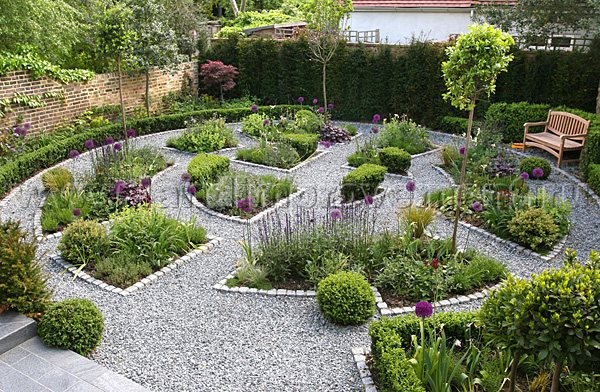

Scope of application
Colored stone for landscape design is used to create colorful drawings on flower beds, to decorate a recreation area. It is also used to form original inscriptions on footpaths. With the help of decorative miniature stones, they perform:
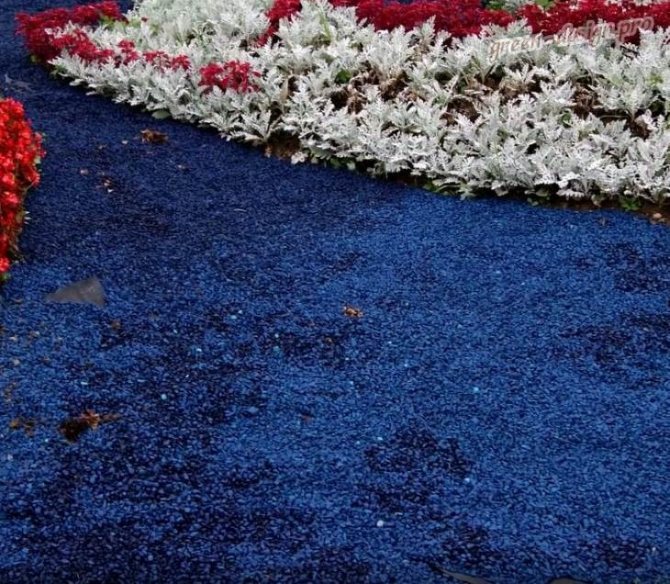

- revenge around the house, pool or gazebos;
- paths on playgrounds for children's games;
- features at the bottom of ponds;
- framing of garden sculptures, monuments.
The decoration of benches with gravel looks original, the area around the planted decorative trees.
Drainage and its purpose
Many houseplants require a soil composition that will provide approximately 50% solids, 35% water, and 15% air. Only a properly laid drainage layer will help to recreate optimal conditions for growth and flowering.
The problem of lack of drainage is that excessive watering displaces air, which is vital for flowers. The lack of oxygen in the soil provokes the development of pathogenic bacteria. The root system begins to rot, and the plant withers. The drainage layer ensures the drainage of excess moisture and good breathability.
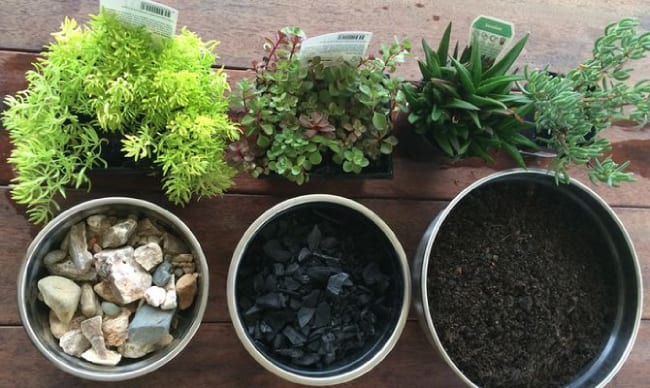

Indoor plants and potted drainage
How to make a flower bed with your own hands
As mentioned earlier, it is quite possible to make a flower bed of stones on your own. Having chosen which species will suit the design of your garden, all that remains is to prepare the material and you can start working.
Did you know? Dubai is home to a true Park of Miracles with up to 45 million flowering plants. In the lifeless sands, you can see an incredible number of flower beds, including in the form of all kinds of pyramids, cars, stars, etc.
Preparation of stones
To form an unusual beautiful flower bed, you can choose a variety of stone materials, namely:
- limestone - allows you to design interesting landscape compositions thanks to a pleasant natural color with an extensive palette of shades: from white to pink and blue. However, it should be noted that the porous structure of the stone is not as strong as we would like. Over the years, precipitation will have a negative impact, small cracks will form on the stones. The problem can be solved by planting ground cover mosses in the formed faults;
- tuff - a kind of limestone with a much stronger structure, but, despite this, it is easy to process. This material is most often used to decorate rocky flower beds. It also has many shades: white, purple, orange, gray, etc .;
- sandstone - just like limestone, it has a porous structure, but does not lose its popularity among landscape designers. Boulders and rubble stones look especially impressive;
- slate - has a layered structure, which is its main feature. The stone has a special shine, it can be divided into separate fragments - plates. The material has a high cost, but at the same time it has a very high strength. Flower beds made from it can last for decades;
- granite - this stone can rightfully be called the most beautiful. The main disadvantage is the high price. The material is capable of oxidizing the soil over time, this must be taken into account when buying vegetation for a flower bed;
- quartzite - the surface of the stone shines and shimmers in the rays of the sun, as it has the ability to reflect light. The mineral has a wide palette of colors;
- basalt - heavy and durable rock that does not absorb moisture and is resistant to corrosion. The stones are gray and black; you can see small greenish-yellow blotches;
- pebbles - good material for creating fences. Bonded with cement, it looks quite neat and is often used for paving.
To this list it is worth adding a decorative stone. The main components in the manufacture of the material are stone chips and acrylic, and polyester resins are used as a connector. The production technology allows you to create a material that successfully imitates different types of boulders. At the same time, decorative blocks are surprisingly strong and durable.
Video description
The video will help you get acquainted with the principles and methods of creating decorative fillings: Many people like this innovative solution. It allows you to revitalize the territory of the garden, to give it an attractive appearance when living plants in late spring have already stopped their active growth, and in early spring the first greens are just beginning to peck.
This might be interesting! In the article at the following link, read about options for creating a decorative wood lattice for a gazebo.
Instructions for use
Most often, garden dumps are used in the design of paths and flower beds. In this case, the laying of the dump does not provide any particular difficulty, and can be done independently:
- Determine the places where the dump will be placed and develop a plan;
- Dig a shallow trench or hole (about 7 cm);
- Lay geotextile or ordinary film on the bottom, but at least 7 millimeters thick;
- If necessary, make cuts in the geotextile or film and plant plants in them; holes must be pierced in the film for water drainage;
- Fill the groove with decorative filler.


Tips from landscape designers:
- Do not under any circumstances cover the root collars of plants;
- It is best to apply sprinkling in spring, in April or May, when the soil has already warmed up and filled with moisture;
- Before starting work, clear the surface of the site from weeds and debris.
You can combine dusts of different colors and shapes with each other, achieving striking effects. m. of soil you will need about 25 kg of wood or 50 kg of stone. The use of organic backfill does not require geotextile or film, it can be placed directly on the ground.
Preliminary stage
Before raising the ground level, a work schedule is drawn up, including planning, collapse of buildings, cleaning the area from debris, drainage and filling. At the stage of preliminary work, topographers are invited to study the soil. They will select the material with precision.
If the top coat is good, it is removed and set aside for later work. Level the area with cheap material, return the soil to its original place. The filling is performed in a prepared space - the success of the work depends on it.
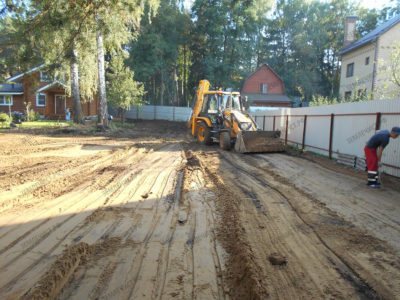

Preparation for raising the ground includes:
- Familiarization. At the stage, the soil for raising the site, composition, holes and their number are studied. The process is short-lived.
- Layout. Data is processed, the location of objects is determined.
- Clearing. Optional step. If there was a house on the territory earlier, they demolish it, dismantle the blockage, take out the garbage.
If, during the preparation of the site, the stumps were uprooted, it will be necessary to backfill the root holes with soil. After removing the site, they proceed to dumping.

